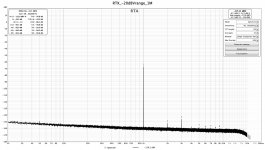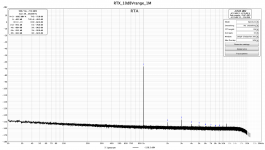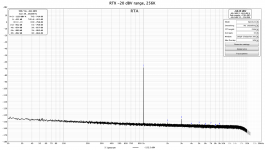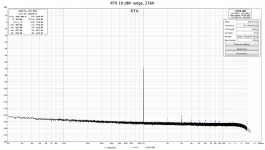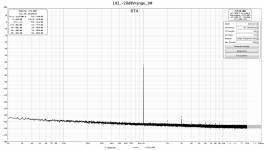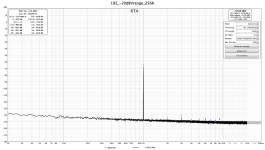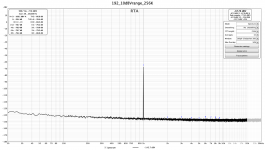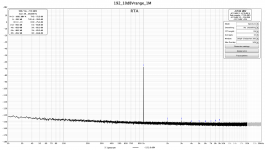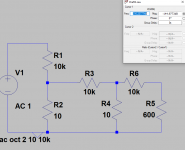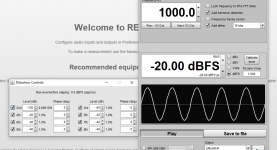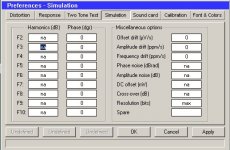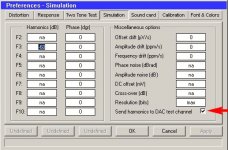To understand better the best RTX setting for ultra-low distortion analysis I did a couple measurements using the Victor oscillator and a notch filter, also from Victor. Specifically, I addressed the difference between lowest noise (-20dBV) or lowest distortion (10dBV) setting on the RTX. I also tested the effect of different sampling rates (44.1 and 192 KHz) and FFT bin sizes (256K and 1M) as I understood from Jan that reducing the sample rate and increasing FFT bin size lowers the noise noise floor.
First up the FFTs recorded @ 44.1 KHz
First up the FFTs recorded @ 44.1 KHz
Attachments
After correction for the amplitude of the fundamental before the notch (14.6 dBV) and the notch attenuation of the harmonic (-9.4 dB), H2 computes as follows:
Sampling rate/RTX input range/FFT bin size
44.1KHz/10dBV/256K -156 dB
44.1KHz/-20dBV/256K -159 dB
44.1KHz/10dBV/1M -159 dB
44.1KHz/-20dBV/1M -158 dB
192kHz/10dBV/256K -152 dB
192kHz/-20dBV/256K -154 dB
192kHz/10dBV/1M -156 dB
192kHz/-20dBV/1M -159 dB
The data suggest:
I) Always better to use the RTX @ -20dBV input setting for this type of measurements.
II) Lowering the sample rate (from 192K to 44.1K) or increasing the FFT bin size (from 256K to 1M) both help in pulling up the harmonics by lowering the noise floor. The effect seems somewhat additive.
III) The measured distortion is essentially the same independently of the settings, as long as the harmonic can be readily identified above the noise floor.
Not really surprising, but still nice to know
Sampling rate/RTX input range/FFT bin size
44.1KHz/10dBV/256K -156 dB
44.1KHz/-20dBV/256K -159 dB
44.1KHz/10dBV/1M -159 dB
44.1KHz/-20dBV/1M -158 dB
192kHz/10dBV/256K -152 dB
192kHz/-20dBV/256K -154 dB
192kHz/10dBV/1M -156 dB
192kHz/-20dBV/1M -159 dB
The data suggest:
I) Always better to use the RTX @ -20dBV input setting for this type of measurements.
II) Lowering the sample rate (from 192K to 44.1K) or increasing the FFT bin size (from 256K to 1M) both help in pulling up the harmonics by lowering the noise floor. The effect seems somewhat additive.
III) The measured distortion is essentially the same independently of the settings, as long as the harmonic can be readily identified above the noise floor.
Not really surprising, but still nice to know
With the notch filter the necessary dynamic range is reduced and you could even add a 40 dB preamp. Since the range is reduced the harmonic contribution of the ADC will be way below the harmonics at the output of the filter. As long as the insertion loss is corrected the harmonic level should be the same. However to be sure of what you see you could add a marker at -120? dB to verify all the gains and losses. A resistive divider would to the task. Two cascaded dividers with shielding because even 120 dB isolation is difficult.
Attached is a simple circuit that can work to get -145 dB from a voltage at the input. The output of the Victor is 600 Ohms (at least on mine). These parts are pretty generic but the capacitance across the 10K resistors will reduce the attenuation at higher frequencies. Absolute precision will require some effort but the 1% parts will get you close and make sure you have all the losses and gains correct.
Attached is a simple circuit that can work to get -145 dB from a voltage at the input. The output of the Victor is 600 Ohms (at least on mine). These parts are pretty generic but the capacitance across the 10K resistors will reduce the attenuation at higher frequencies. Absolute precision will require some effort but the 1% parts will get you close and make sure you have all the losses and gains correct.
Attachments
markers
Cheers,
E.
Should I implement this "nice thing" also into DiAna? (not that difficult, as there is already a simulation menu)Yes that is a good check. The nice thing with the REW is that it has a menu to add harmonics to the test signal, you can select any harmonic (also combined) from the 2nd to the 9th, at arbitrary magnitude and phase.
Jan
Cheers,
E.
Attachments
Hi Manolis,Edmond, it would be a nice future for the DiAna.
I'm working on it (see pic.)
Cheers,
E.
Attachments
One caution about generating harmonics with a DAC- the uncertanty of the ADC is also an issue of the DAC. While a digital -120 dB harmonic of a certain phase can be created very precisely, the digital to analog conversion may (will) alter its accuracy. This is why it would need to be checked with any specific instance of a DAC. Especially if the DAC has a -130 dB distortion product and another is placed on top of it I think it would need to be at least 10 dB stronger to be reasonably close to the correct value. However this is the kind of thing Pavel's distortion correction effort has been approaching pretty successfully.
Maybe adding a non-harmonic tone would be better as a level pilot to verify level.
Maybe adding a non-harmonic tone would be better as a level pilot to verify level.
These are good points, but.... the THD spectrum of DiAna is insensitive to non-harmonic signals. So when adding a (magnitude) pilot signal, its amplitude must be well above the distortion level of the ADC and DAC. No problem, I would say, because it's not my intention to use this pilot in order to test the measurement floor, rather to check the attenuation of band-pass and band-stop filters.One caution about generating harmonics with a DAC- the uncertanty of the ADC is also an issue of the DAC. While a digital -120 dB harmonic of a certain phase can be created very precisely, the digital to analog conversion may (will) alter its accuracy. This is why it would need to be checked with any specific instance of a DAC. Especially if the DAC has a -130 dB distortion product and another is placed on top of it I think it would need to be at least 10 dB stronger to be reasonably close to the correct value. However this is the kind of thing Pavel's distortion correction effort has been approaching pretty successfully.
Maybe adding a non-harmonic tone would be better as a level pilot to verify level.
Cheers,
E.
Yes, that would e great!
Should I implement this "nice thing" also into DiAna? (not that difficult, as there is already a simulation menu)
Cheers,
E.
FYI - the USB async implicit feedback of RTX6001 will be supported in the next linux kernel (likely 5.9, probably too late for 5.8) [PATCH] Add implicit feedback quirk for RTX6001
Forgive me for not wading through all 296 pages of this thread after coming back to this topic several years later. Is there a better ADC card at a reasonable price (up to € 250) out there than the AK5394A-based e-mus?
I saw 1audio post -132 dB 2nd and 3rd for emus after replacing the reference filter caps on the ADC in another thread. Any more data on the measurement conditions?
Does the PCM4220 get any better in terms of harmonics? Its nominal specs are the same as the AK5394(A) when expressed as THD+N or DR.
Is the AK5397 the best ADC out there now? Any cards to recommend?
I saw 1audio post -132 dB 2nd and 3rd for emus after replacing the reference filter caps on the ADC in another thread. Any more data on the measurement conditions?
Does the PCM4220 get any better in terms of harmonics? Its nominal specs are the same as the AK5394(A) when expressed as THD+N or DR.
Is the AK5397 the best ADC out there now? Any cards to recommend?
The AK5394A is still the lowest distortion option. You have it in the EMU m series and in the Lynx L22. There are some pro boxes using it but that's not useful.
The AK5397 is in the QA401 and its probably the best value for an audio testing device. You give up a little in ultimate distortion but a passive notch can work around that.
The AK5397 is in the QA401 and its probably the best value for an audio testing device. You give up a little in ultimate distortion but a passive notch can work around that.
Or may look as a DIY at ADC AK5572 – Very high performance audio AD-converter – nihtila.com and interface with a SPDIF ... also dual mono configuration possible.
Hp
Hp
Thanks, Demian.
I didn't realize the 5497 traded lower noise for higher distortion. That probably explains why it didn't make it into the RTX6001.
How do the L22 vs. the emu m-series compare in stock form? The advantage of the L22 is obviously that have up to date win10 drivers, and maybe that it is easier to mod the front end and clock. The downsides would be poor DAC and that it sits inside the computer.
Has anyone tested the PCM4220 / 4222? All I found was Rja4000 posting at audio science review about the PCM4222EVM with RME Pro fs as a source. SINAD was better than QA401 but HD3 was -109 dB at full scale. No information on harmonics at less than fs.
On paper, the 4220 looks on par with the 5394A
THD+N at -1 dB: -108 vs. -110 (mirroring Rja's results)
THD+N at -60 dB: -61 vs. -60 (so the PCM might have a slight edge at low level - is it noise or harmonics)
DR (A-weighted): 123 vs 123
Are THD+N and S/(N+D) as specified for the AKM really the same under all circumstances?
The attraction of the PCM4220 is that it can be found in the consumer X-fi Titanium HD which sells used for about € 60.
Lastly, how does the AK5574 compare to [5397] and (5394A)?
S/(N+D) at -1 dB: 112 [108 but 110 at -2 dB] (110)
S/(N+D) at -20 dB: 97 [102] (100)
S/(N+D) at -60 dB: 57 [64] (60)
DR (A-weigthed): 121 dB single channel but 127 in 4-to-1 [127 but 130 mono mode] (123)
Looks like the 5397 is the overall winner on noise but for measurements, provided there are no idle tones or the lke, all it takes is averaging to get rid of that. On harmonics, the 5574 looks strong at high level but appears to drop the ball at lower levels. If one stays at -2 dB or below, the 5397 looks like the winner, contrary to what Demian said, but the data sheets probably give a skewed picture. Especially for the 5397, the note 10 buffer seems to make a huge difference on S/(N+D). For the 5394A, the fig. 9 buffer and the 1000 µF ref cap seem to improve S/(N+D) but are detrimental for DR (?!).
Cards with 5574 are currently the RME ADI-2 Pro fs, the UADC4 and possibly the ADI-2 fs (no Pro), all well north of € 500. Probably not worth shelling out that kind of money compared to an EMU for measureing harmonics?
I didn't realize the 5497 traded lower noise for higher distortion. That probably explains why it didn't make it into the RTX6001.
How do the L22 vs. the emu m-series compare in stock form? The advantage of the L22 is obviously that have up to date win10 drivers, and maybe that it is easier to mod the front end and clock. The downsides would be poor DAC and that it sits inside the computer.
Has anyone tested the PCM4220 / 4222? All I found was Rja4000 posting at audio science review about the PCM4222EVM with RME Pro fs as a source. SINAD was better than QA401 but HD3 was -109 dB at full scale. No information on harmonics at less than fs.
On paper, the 4220 looks on par with the 5394A
THD+N at -1 dB: -108 vs. -110 (mirroring Rja's results)
THD+N at -60 dB: -61 vs. -60 (so the PCM might have a slight edge at low level - is it noise or harmonics)
DR (A-weighted): 123 vs 123
Are THD+N and S/(N+D) as specified for the AKM really the same under all circumstances?
The attraction of the PCM4220 is that it can be found in the consumer X-fi Titanium HD which sells used for about € 60.
Lastly, how does the AK5574 compare to [5397] and (5394A)?
S/(N+D) at -1 dB: 112 [108 but 110 at -2 dB] (110)
S/(N+D) at -20 dB: 97 [102] (100)
S/(N+D) at -60 dB: 57 [64] (60)
DR (A-weigthed): 121 dB single channel but 127 in 4-to-1 [127 but 130 mono mode] (123)
Looks like the 5397 is the overall winner on noise but for measurements, provided there are no idle tones or the lke, all it takes is averaging to get rid of that. On harmonics, the 5574 looks strong at high level but appears to drop the ball at lower levels. If one stays at -2 dB or below, the 5397 looks like the winner, contrary to what Demian said, but the data sheets probably give a skewed picture. Especially for the 5397, the note 10 buffer seems to make a huge difference on S/(N+D). For the 5394A, the fig. 9 buffer and the 1000 µF ref cap seem to improve S/(N+D) but are detrimental for DR (?!).
Cards with 5574 are currently the RME ADI-2 Pro fs, the UADC4 and possibly the ADI-2 fs (no Pro), all well north of € 500. Probably not worth shelling out that kind of money compared to an EMU for measureing harmonics?
- Home
- Design & Build
- Equipment & Tools
- DIY Audio Analyzer with AK5397/AK5394A and AK4490
